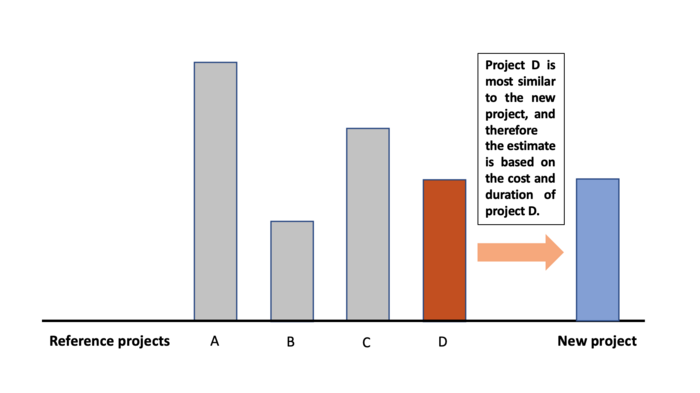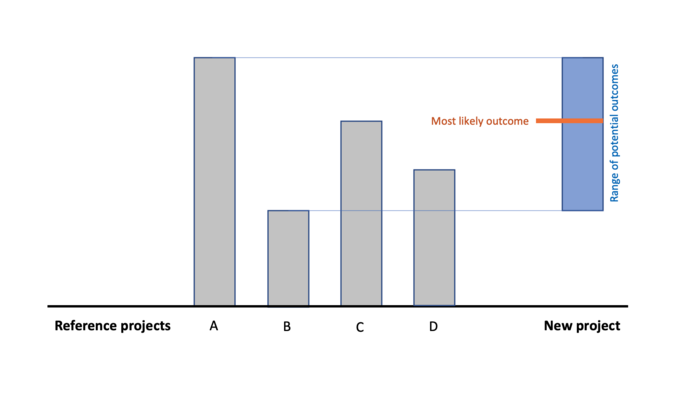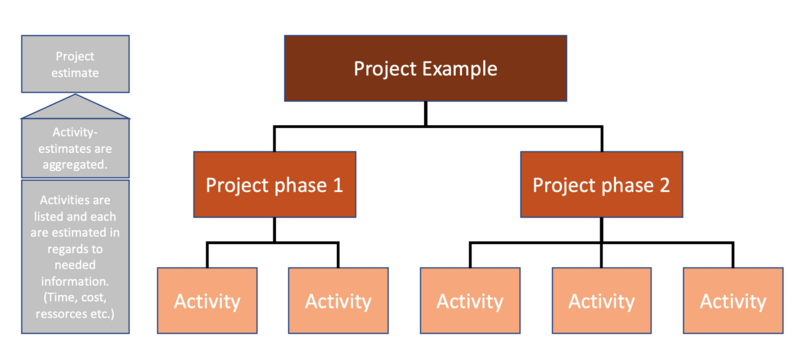Top-down vs bottom-up estimations
Written by Oliver K. Vittrup
Contents |
Abstract
When starting a new project, an important task for the project manager, is the estimation process. This can both be an estimation regarding cost and time-frames. It is important to get the project off to a good start, given that success of the project depends on the estimation - both in regards to time and cost. When estimating (or in other words 'predicting the future'), the project manager can use the following methods:
- Top-down estimating
- Bottom-up estimating
By choosing the top-down approach, the project manager chooses to make an overall scope of the project. From here, the major elements of the project is being listed and estimated separately. This approach creates a rough idea of the project size and the different timeframes of the project elements. The advantages of using the top-down approach is less time consuming and requires a limited amount effort. The estimates created by this method often turns out larger than the ones, which has been found using the bottom-up approach. [1]
The bottom-up approach is on the other hand a very time-consuming and costly method, but it gives a more accurate estimate of the project time and cost. By using the bottom-up approach, the cost and time frame is being calculated for every activity related to the project. The values and time frames are then aggregated in order to estimate the total cost and project time. [2] The bottom-up approach is often used in order to gain stakeholders to buy in on the project.
Big idea
The term 'estimating' in terms of project management can be defined as "the process of predicting the cost and time needed to deliver project products". [3] The estimation part is an important step on the way of getting a good product, which satisfies the costumer and/or the user, when it is delivered in the end. The estimation process is used in order to predict the cost and the duration of a given project, which is making it possible to make the decisions, which will benefit the project. When estimating, it is also possible to make a decision regarding the viability of the project, when the financial requirements has been determined.
The duration of a project is important to know in regards to costumer expectations and in order to know when the product can be delivered. From the estimation process, the project manager can use the determined time frames for time scheduling, which is relevant informations for interested stakeholders. During the project, the project manager can hold the real time data up against the estimated values in order to monitor the performance of the project. [3]
Project estimations can be a fast task, but it can also be very time consuming. This all comes down to how the project manager wishes to prioritize the estimation, and is a decision on whether the time used on estimating is worth the effort in the end. The estimation process can be carried out by using top-down estimating as well as the bottom-up estimating.
Top-down estimating
Top-down estimating, also refered to as analogous estimating, defines the way of estimating based on the information which is available about the project at the moment. The tool often uses similar projects as guide lines in regards to tasks, cost and project durations. The top-down approach is a fast and efficient way of estimating, but can leave out information, which is unique to the particular project, and the result can therefore be different from the real price and duration. [4]
Top-down estimating can be done in four different ways. [5]:
- a single-point estimate
- a ratio estimate
- an estimate range
- a three-point estimate
Bottom-up estimating
The bottom-up estimating approach is to be used, when a detailed estimate is needed for the project. By using the bottom-up estimation, the project cost and duration is estimated on a task specific level, allowing the project manager to plan each and every task. The task costs and durations can then be aggregated in the end, which will result in a very detailed project estimate. This approach also makes it possible to estimate the amount of resources needed for the project. [6]
The big differences between the to estimation techniques is that the top-down estimating can be used for any level of of the project phase, even when information may be limited. On the other hand, it is fairly common that the bottom-up approach is used, when a lot of knowledge has been obtained about the project.
Application
The two different tools used for estimation purposes can be used in different times of the project phase.
Top-down estimating
The top-down estimating strategy can be put into work when
- the project has a limited amount of information available
- the project manager wants a fast and cheap estimation of the project cost and duration
- the project manager needs to see the big picture and an accurate estimate is not needed
The top-down estimating can be used as a starting point for the bottom-up estimate. This gives a quick introduction to the project, which if needed, can be analyzed further. The technique works best and gives the most reliable estimates, when the project is similar to an earlier finished project, and the assumptions regarding the similarities is correct.[5] As mentioned earlier, the top-down estimation can be performed in four different ways, which will be briefly described.
Single-point estimate
This technique within the top-down estimation, defines the way of estimating the project from the most similar project performed earlier. Therefore, the project is analyzed and compared to projects in the same category as itself, and then estimated on the background of the most similar one. If the reference project cost 500.000 DKK, the top-down estimate for the new project would then be similar equal to 500.000 DKK.[5]. A visual example of the single-point estimation technique can be seen from the following figure.

Ratio estimate
A ratio estimate compares the new project to a reference project with enough similarities. The two projects are then compared in regards to size, which gives a ratio between them. As an example, the project estimators would believe that the new project would take 130% of the reference project, which increases the cost, duration and need for resources following this ratio.[5].
Estimate range
An estimate range shows the price range between a series of earlier performed projects similar to the new project planned. The estimate range is then going from the cheapest project up to the most expensive. The estimate range would often be made with a 'most likely'-estimate.[5] A visual example of the estimate range can be seen from the following figure.

Three-point estimate
This approach requires the project manager to make three estimates, which includes an optimistic estimate, a pessimistic estimate and a most likely estimate. They are then to be converted into a final estimate.[5]
Bottom-up estimating
The bottom-up estimating can be used for estimating
- the needed time for the project (aggregated task durations)
- the resources needed for the project
- the project cost
The bottom-up estimating technique should be put into work when the project is in a place, where it needs accurate predictions regarding future. This can be, as shown in the bulletpoints, in regards to duration, cost and resources.
The different estimates can also depend on each other. The task duration will often depend on the resources, which has been assigned to the specific task. The cost is estimated from the time- and resource estimates by multiplying them with the price per unit.[6] This is differentiated from company to company.
The bottom-up estimating is performed at the lowest level with-in the 'Work breakdown structure', which is where all of the activities within a given project has been named and listed. An example of this can be seen from the following figure.

Limitations
The two different estimation techniques each have their limitations, when being used for cost- and duration estimations. These will be listed below:
Top-down estimating
The main limitations, or consequences, which is present when using the top-down estimating technique, is listed below.[5]
- The use of the top-down estimation gives a rough and not quite accurate picture of the project.
- When comparing the current project to an earlier finished reference project, the assumptions regarding similarities between them has to be correct. If the assumptions were wrong, the determined estimate would then be useless for the project.
- The potential inaccuracy in regards to the results, makes it harder to make decisions and project planning based on the estimates found from using the top-down approach.
Bottom-up estimating
The main limitations, or consequences, which is present when using the bottom-down estimating technique, is listed below.[6]
- The bottom-up estimation technique is expensive to do, both in regards to effort and time, and from this resources needed for the process.
- The estimation regarding the cost of the project relies on the estimated time frames, which is then relying on the estimated resources needed for the project. From this, the estimation could be incorrect, if error occurs in one of these estimates.
- If the project is at a large scale, the estimates made with the bottom-up estimation could be ignoring the possibility of integration efforts in regards to the listed project tasks.
Annotated Bibliography
- project-management.info offers a broad palette of information within the field of project management. It also offers a more detailed description of the tools described in this article. The articles on project-management.info also shows the tool in a visual manner, which makes the theory easier to understand and use.
- apm.org.uk is the official site of the Association for Project Management. They describe their goal as "Inspiring communities to deliver meaningful change for societal benefit by advancing the art, science, theory and practice of project management."
- pmstudycircle.com is a website made from a student, frustrated about the missing information about project management available on the web, when he was writing his exam. Here he has gathered a lot of relevant information about project management.
References
- ↑ Rowland, M. 2019. Three ways to approach cost estimation. [online] Available at: https://www.apm.org.uk/blog/three-ways-to-approach-cost-estimation/ [Accessed February 18th 2021].
- ↑ Project Management: A guide to the Project Management Body of Knowledge (PMBOK guide), 6th Edition (2017)
- ↑ 3.0 3.1 Bugajenko, O. Top-Down & Bottom-Up Estimating Techniques in Project Management. [online] Available at: https://study.com/academy/lesson/top-down-bottom-up-estimating-techniques-in-project-management.html [Accessed February 18th 2021].
- ↑ Usmani, F. 2020. 4 Tools to Estimate Costs in the Project Management. [online] Available at: https://pmstudycircle.com/2012/06/4-tools-to-estimate-costs-in-the-project-management/ [Accessed February 18th 2021]
- ↑ 5.0 5.1 5.2 5.3 5.4 5.5 5.6 Sebastian. Analogous Estimating. Definition, Examples, Pros & Cons. [online] Available at: https://project-management.info/analogous-estimating/ [Accessed February 18th 2021]
- ↑ 6.0 6.1 6.2 Sebastian. Bottom Up Estimating. Definition, Examples, Pros & Cons. [online] Available at: https://project-management.info/bottom-up-estimating-definition-example-pros-cons/ [Accessed February 18th 2021].